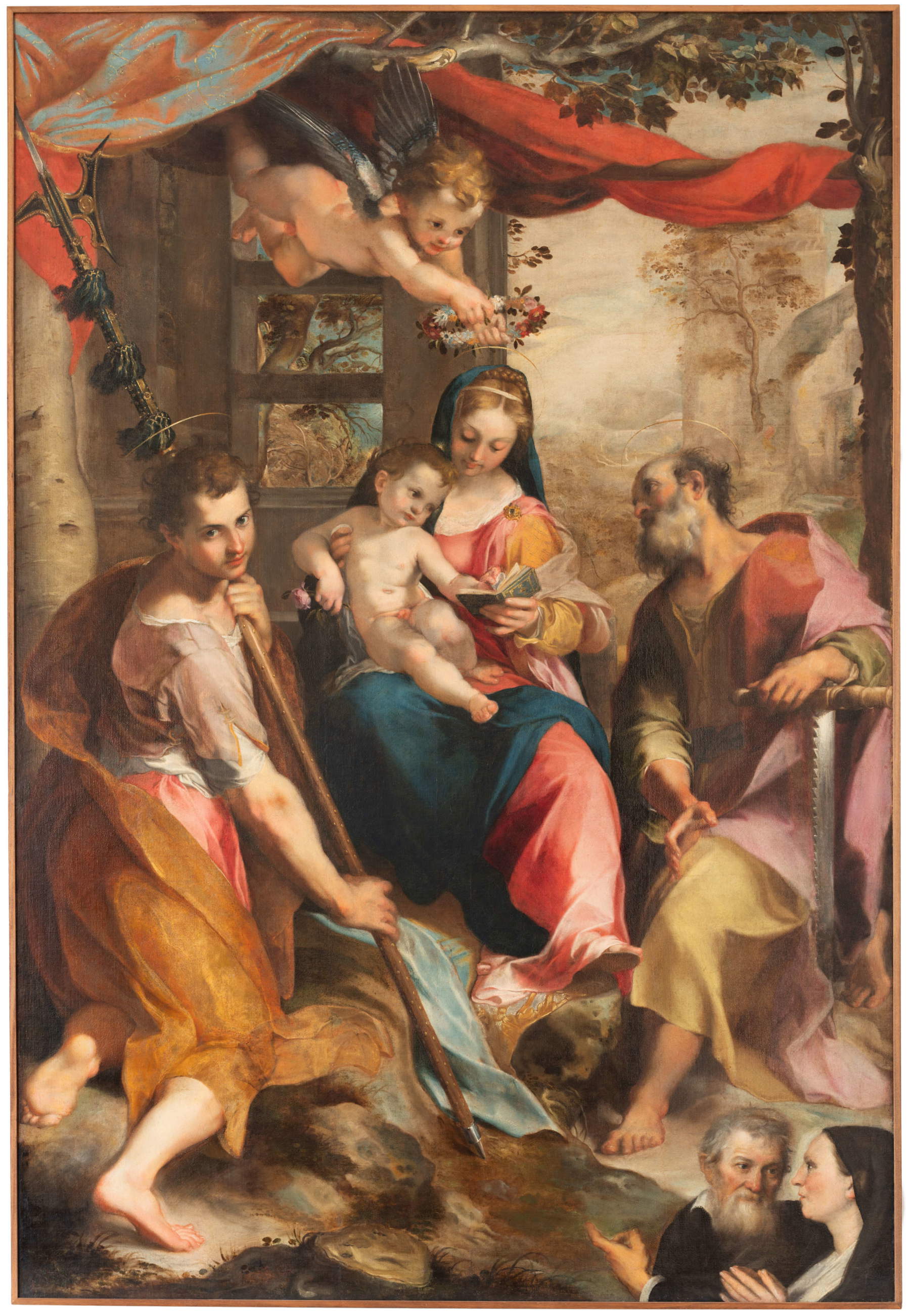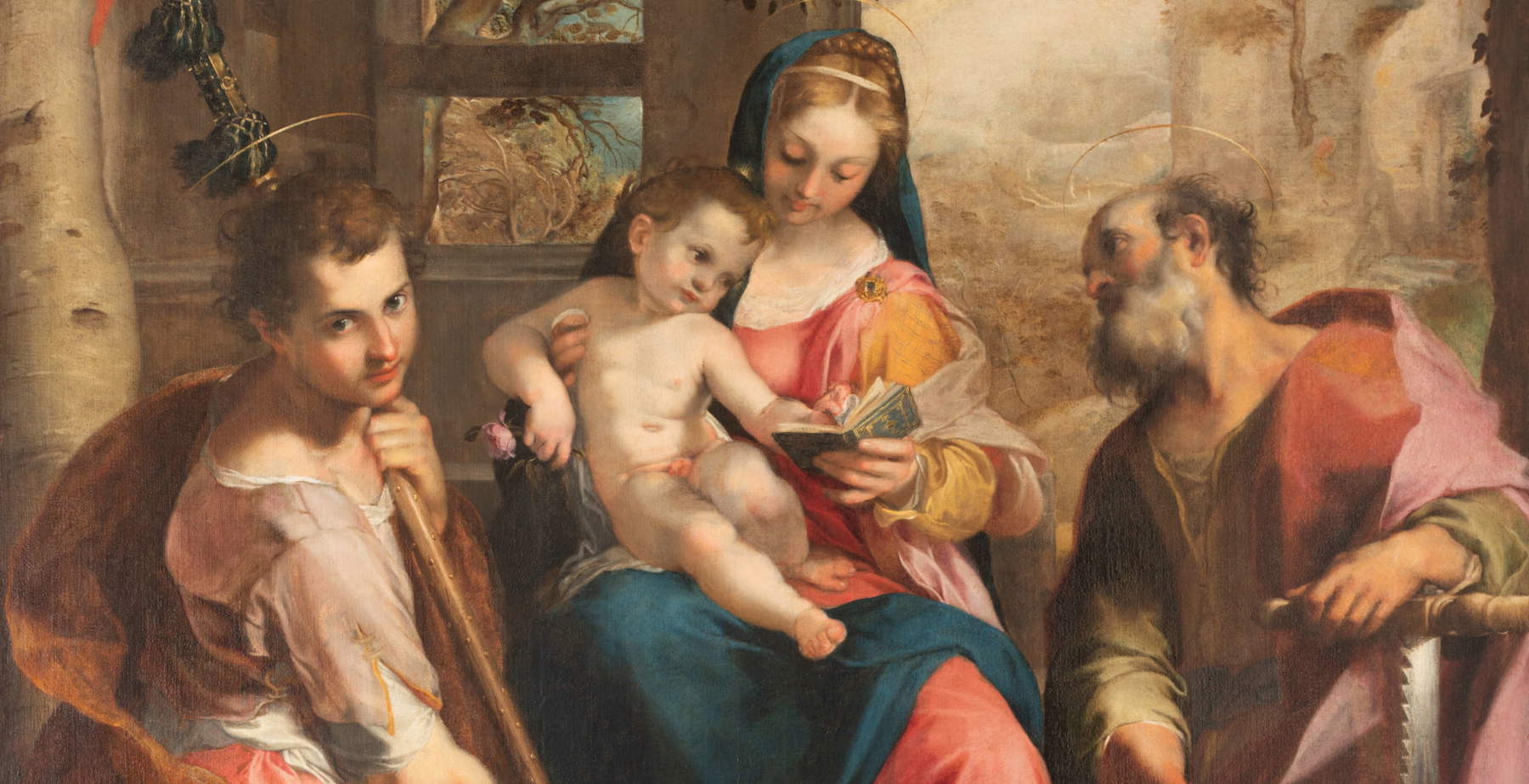From Dec. 4, 2024 to Jan. 12, 2025, the new Palazzo Marino Christmas exhibition arrives in Milan : in fact, for several years now the City of Milan has been used to hosting a one-work exhibition for the holidays. This year the star is the Madonna and Child with Saints Simon and Judas by Federico Barocci (Urbino, 1533 - 1612), known as The Madonna of Saint Simon. The exhibition, set up in the Alessi Hall, is as always free admission.
The impressive altarpiece, painted between 1566 and 1567, measures 283 by 190 cm and is one of the most representative works of Barocci’s career. The Urbino artist, known for the sensitivity of his colors and the humanity of his figures, was chosen because of his connection with Milan and Federico Borromeo, archbishop of Milan and a great art lover, who made the Lombard capital a center open to Italian and European artistic influences. The work is a clear example of Barocci’s innovative style, heir to the tradition of Raphael, but with a wholly personal poetics capable of speaking to the heart.
The exhibition layout was curated by architect Franco Achilli in collaboration with Valerio Rigamonti, with illustrations by Carlo Stanga and graphic design by Paola Pellizzi. The City of Milan, together with Intesa Sanpaolo, made the event possible, which will be accompanied by a catalog edited by Skira Editore.
The exhibition will be open to the public free of charge from Dec. 4, 2024, until Jan. 12, 2025, with continuous hours from 9:30 a.m. to 8 p.m. Some changes in hours are planned for holidays: on December 7, opening will be limited to the morning (closing time 12 noon, last entry 11:30 a.m.), while on December 24 and 31, closing time will be earlier at 6 p.m. On holidays, including Dec. 8, 26 and Jan. 6, the exhibition will be open according to regular hours, while on Dec. 25 it will open from 2:30 to 6:30 p.m.

Federico Barocci, considered the heir to Raphael’s classicism, spent most of his life in Urbino, far from the big cities of the time. Nevertheless, he managed to maintain relationships with important figures, such as Cardinal Borromeo, who acquired one of his Nativity paintings now in the Pinacoteca Ambrosiana. Unlike other Renaissance artists, Barocci chose not to move to Rome and preferred to work in Urbino, a city that, thanks in part to names such as Piero della Francesca and Donato Bramante, had experienced a glorious artistic era under the dukes of Montefeltro.
Giorgio Vasari described Barocci as a “young man of great expectation,” seeing in him a promise destined to bring glory back to the ducal court. Barocci, at the age of 30, after working on important commissions in Rome, decided to remain in his hometown, though he continued to collaborate with personalities such as Duke Francesco Maria II della Rovere. His life and career were thus marked by loyalty to his homeland, which is also reflected in his careful and sentimental pictorial language.
The Madonna di San Simone, painted in 1567 for the church of San Francesco in Urbino, is considered a mature work, revealing Barocci’s unique technique and poetics. In it, the Virgin teaches the Child Jesus to read, a scene that evokes a particular sweetness and tenderness, influenced by the art of Correggio. St. Jude Thaddeus, recognizable by his halberd, and St. Simon, with the saw of martyrdom, are the two saints depicted next to the Virgin. In the background to the right are portraits of the work’s donors, symbolic of the devotion that Urbino’s nobility and elites devoted to sacred worship.
The curators of the exhibition at Palazzo Marino, Luigi Gallo and Anna Maria Ambrosini Massari, emphasize the importance of this work, called “a culmination of Federico’s early maturity.” The Madonna di San Simone best represents Barocci’s emotional and intimate language, capable of uniting human subjects with the surrounding nature with a dynamism and gentleness that win the viewer’s heart. The exhibition thus allows the viewer to experience a painting that combines realistic elements with a typically Franciscan warmth.
Next to the altarpiece, Palazzo Marino displays an autograph drawing by Barocci, on loan from the Castello Sforzesco’s Drawings Cabinet. This sketch, made between 1575 and 1579, is a fragment of a preparatory cartoon for the Madonna del Popolo altarpiece and offers an intimate glimpse into Barocci’s creative method. The charcoal and white chalk drawing reveals the steps through which the artist defined the outlines of his figures before transferring them to canvas.
The choice to exhibit this drawing is intended to provide an opportunity to delve into the technical details and stages of elaboration of a Renaissance work. The interest in Barocci’s creative process also testifies to the educational value of the exhibition, which brings the public closer to art history not only as a finished product, but as the result of deep and methodical study.
In conjunction with the exhibition at Palazzo Marino, the City of Milan is launching the Natale nei Borghi (Christmas in the Villages) initiative, a series of free guided tours to be held from Dec. 14 to Jan. 5. The tours, organized in collaboration with the Associazione Antichi Borghi Milanesi, will offer the opportunity to discover 18 places of artistic and historical interest scattered throughout the city’s nine boroughs.
This initiative was created with the aim of enhancing not only the treasures of the center, but also the artistic beauties found in the suburbs, allowing visitors to immerse themselves in the lesser-known history of Milan and its ancient boroughs. The proposal is part of a cultural vision that sees art as a unifying and inclusive element, capable of embracing the entire urban fabric.
 |
| Milan, this year Federico Barocci for the city's Christmas exhibition. |
Warning: the translation into English of the original Italian article was created using automatic tools. We undertake to review all articles, but we do not guarantee the total absence of inaccuracies in the translation due to the program. You can find the original by clicking on the ITA button. If you find any mistake,please contact us.